Conflict Management Styles of Nurse Managers
VerifiedAdded on 2022/09/17
|8
|1864
|16
AI Summary
Contribute Materials
Your contribution can guide someone’s learning journey. Share your
documents today.

Running head: LEADING AND LEARNING: BUILDING PROFESSIONAL CAPACITY 1
LEADING AND LEARNING: BUILDING PROFESSIONAL CAPACITY
Name of Student
Institutional Affiliation
Word count: 1277
LEADING AND LEARNING: BUILDING PROFESSIONAL CAPACITY
Name of Student
Institutional Affiliation
Word count: 1277
Secure Best Marks with AI Grader
Need help grading? Try our AI Grader for instant feedback on your assignments.
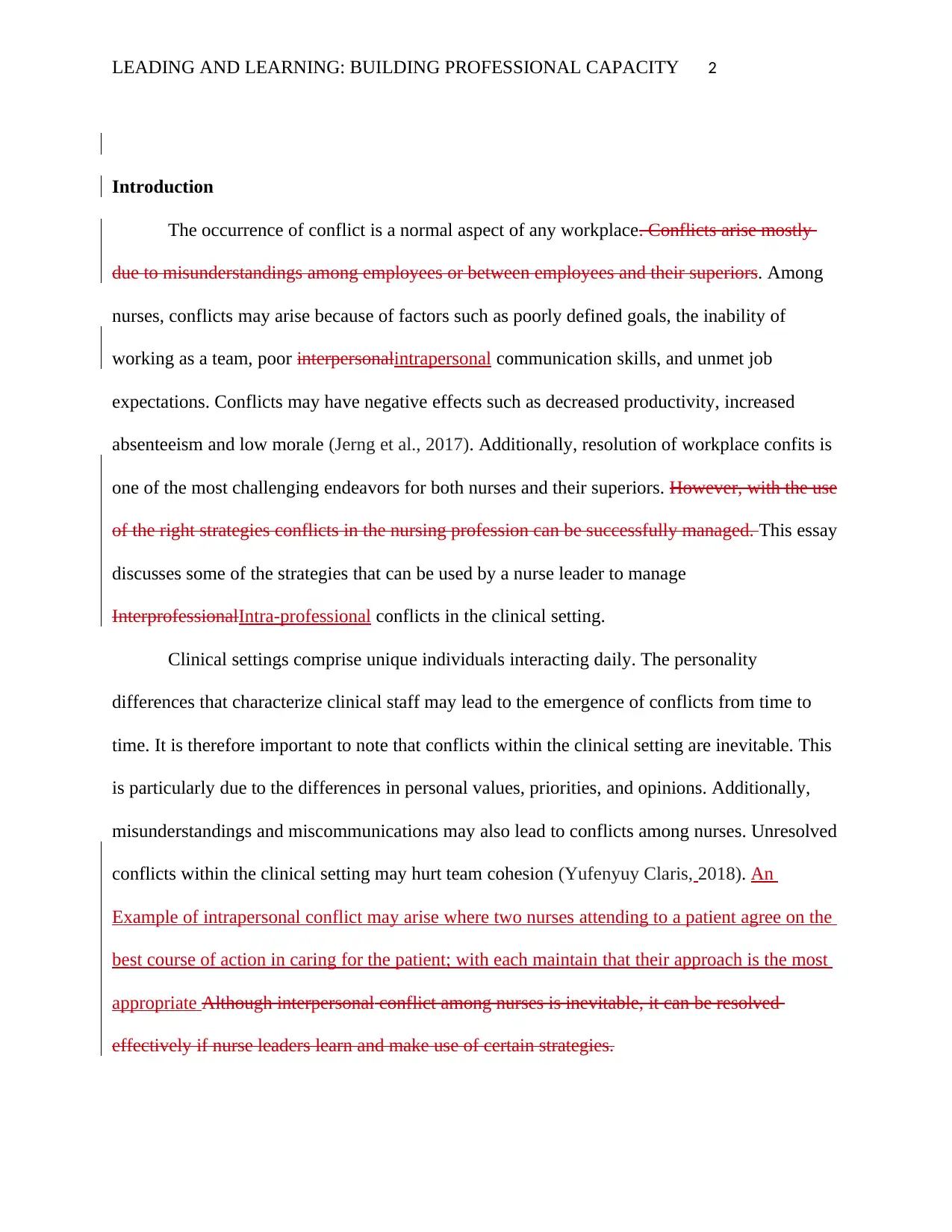
LEADING AND LEARNING: BUILDING PROFESSIONAL CAPACITY 2
Introduction
The occurrence of conflict is a normal aspect of any workplace. Conflicts arise mostly
due to misunderstandings among employees or between employees and their superiors. Among
nurses, conflicts may arise because of factors such as poorly defined goals, the inability of
working as a team, poor interpersonalintrapersonal communication skills, and unmet job
expectations. Conflicts may have negative effects such as decreased productivity, increased
absenteeism and low morale (Jerng et al., 2017). Additionally, resolution of workplace confits is
one of the most challenging endeavors for both nurses and their superiors. However, with the use
of the right strategies conflicts in the nursing profession can be successfully managed. This essay
discusses some of the strategies that can be used by a nurse leader to manage
InterprofessionalIntra-professional conflicts in the clinical setting.
Clinical settings comprise unique individuals interacting daily. The personality
differences that characterize clinical staff may lead to the emergence of conflicts from time to
time. It is therefore important to note that conflicts within the clinical setting are inevitable. This
is particularly due to the differences in personal values, priorities, and opinions. Additionally,
misunderstandings and miscommunications may also lead to conflicts among nurses. Unresolved
conflicts within the clinical setting may hurt team cohesion (Yufenyuy Claris, 2018). An
Example of intrapersonal conflict may arise where two nurses attending to a patient agree on the
best course of action in caring for the patient; with each maintain that their approach is the most
appropriate Although interpersonal conflict among nurses is inevitable, it can be resolved
effectively if nurse leaders learn and make use of certain strategies.
Introduction
The occurrence of conflict is a normal aspect of any workplace. Conflicts arise mostly
due to misunderstandings among employees or between employees and their superiors. Among
nurses, conflicts may arise because of factors such as poorly defined goals, the inability of
working as a team, poor interpersonalintrapersonal communication skills, and unmet job
expectations. Conflicts may have negative effects such as decreased productivity, increased
absenteeism and low morale (Jerng et al., 2017). Additionally, resolution of workplace confits is
one of the most challenging endeavors for both nurses and their superiors. However, with the use
of the right strategies conflicts in the nursing profession can be successfully managed. This essay
discusses some of the strategies that can be used by a nurse leader to manage
InterprofessionalIntra-professional conflicts in the clinical setting.
Clinical settings comprise unique individuals interacting daily. The personality
differences that characterize clinical staff may lead to the emergence of conflicts from time to
time. It is therefore important to note that conflicts within the clinical setting are inevitable. This
is particularly due to the differences in personal values, priorities, and opinions. Additionally,
misunderstandings and miscommunications may also lead to conflicts among nurses. Unresolved
conflicts within the clinical setting may hurt team cohesion (Yufenyuy Claris, 2018). An
Example of intrapersonal conflict may arise where two nurses attending to a patient agree on the
best course of action in caring for the patient; with each maintain that their approach is the most
appropriate Although interpersonal conflict among nurses is inevitable, it can be resolved
effectively if nurse leaders learn and make use of certain strategies.
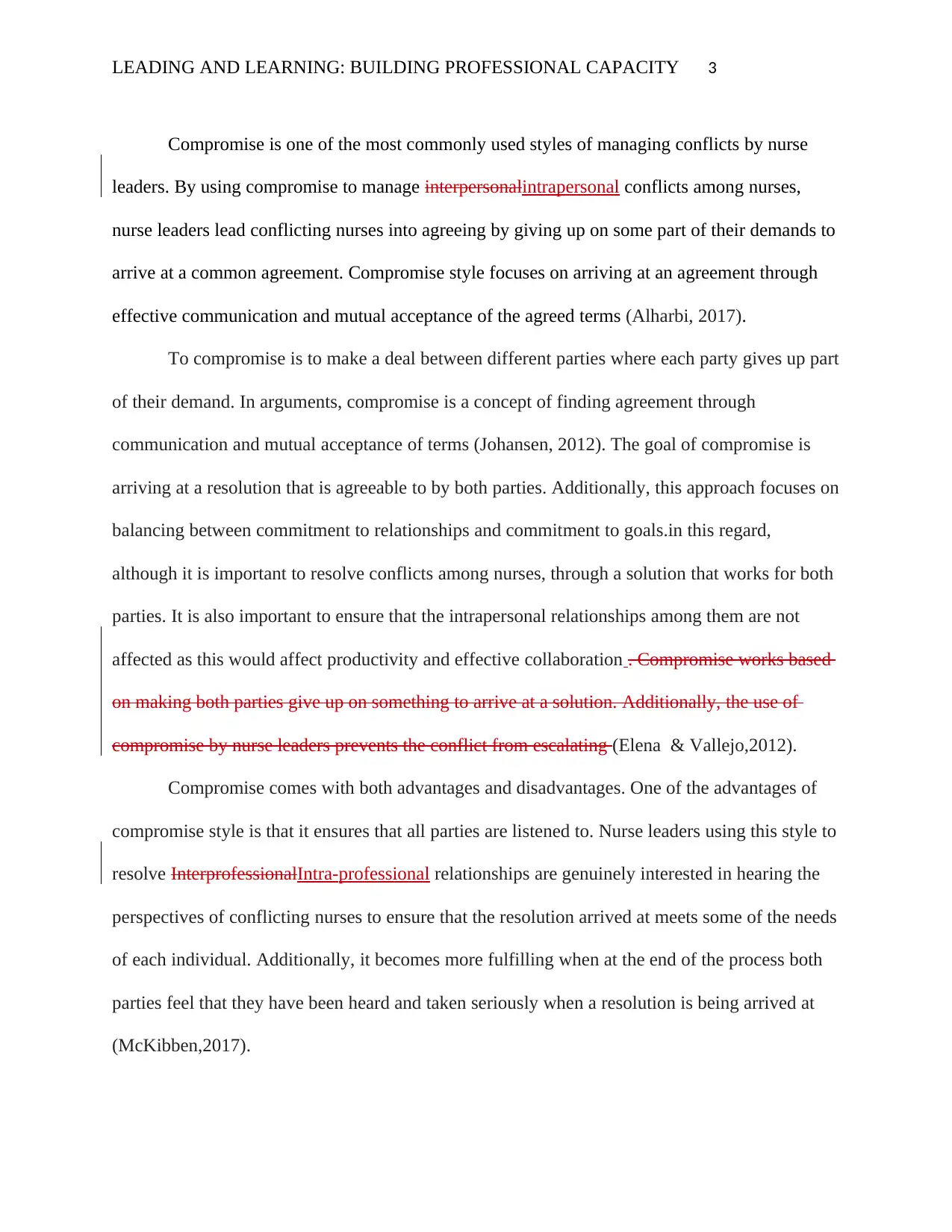
LEADING AND LEARNING: BUILDING PROFESSIONAL CAPACITY 3
Compromise is one of the most commonly used styles of managing conflicts by nurse
leaders. By using compromise to manage interpersonalintrapersonal conflicts among nurses,
nurse leaders lead conflicting nurses into agreeing by giving up on some part of their demands to
arrive at a common agreement. Compromise style focuses on arriving at an agreement through
effective communication and mutual acceptance of the agreed terms (Alharbi, 2017).
To compromise is to make a deal between different parties where each party gives up part
of their demand. In arguments, compromise is a concept of finding agreement through
communication and mutual acceptance of terms (Johansen, 2012). The goal of compromise is
arriving at a resolution that is agreeable to by both parties. Additionally, this approach focuses on
balancing between commitment to relationships and commitment to goals.in this regard,
although it is important to resolve conflicts among nurses, through a solution that works for both
parties. It is also important to ensure that the intrapersonal relationships among them are not
affected as this would affect productivity and effective collaboration . Compromise works based
on making both parties give up on something to arrive at a solution. Additionally, the use of
compromise by nurse leaders prevents the conflict from escalating (Elena & Vallejo,2012).
Compromise comes with both advantages and disadvantages. One of the advantages of
compromise style is that it ensures that all parties are listened to. Nurse leaders using this style to
resolve InterprofessionalIntra-professional relationships are genuinely interested in hearing the
perspectives of conflicting nurses to ensure that the resolution arrived at meets some of the needs
of each individual. Additionally, it becomes more fulfilling when at the end of the process both
parties feel that they have been heard and taken seriously when a resolution is being arrived at
(McKibben,2017).
Compromise is one of the most commonly used styles of managing conflicts by nurse
leaders. By using compromise to manage interpersonalintrapersonal conflicts among nurses,
nurse leaders lead conflicting nurses into agreeing by giving up on some part of their demands to
arrive at a common agreement. Compromise style focuses on arriving at an agreement through
effective communication and mutual acceptance of the agreed terms (Alharbi, 2017).
To compromise is to make a deal between different parties where each party gives up part
of their demand. In arguments, compromise is a concept of finding agreement through
communication and mutual acceptance of terms (Johansen, 2012). The goal of compromise is
arriving at a resolution that is agreeable to by both parties. Additionally, this approach focuses on
balancing between commitment to relationships and commitment to goals.in this regard,
although it is important to resolve conflicts among nurses, through a solution that works for both
parties. It is also important to ensure that the intrapersonal relationships among them are not
affected as this would affect productivity and effective collaboration . Compromise works based
on making both parties give up on something to arrive at a solution. Additionally, the use of
compromise by nurse leaders prevents the conflict from escalating (Elena & Vallejo,2012).
Compromise comes with both advantages and disadvantages. One of the advantages of
compromise style is that it ensures that all parties are listened to. Nurse leaders using this style to
resolve InterprofessionalIntra-professional relationships are genuinely interested in hearing the
perspectives of conflicting nurses to ensure that the resolution arrived at meets some of the needs
of each individual. Additionally, it becomes more fulfilling when at the end of the process both
parties feel that they have been heard and taken seriously when a resolution is being arrived at
(McKibben,2017).

LEADING AND LEARNING: BUILDING PROFESSIONAL CAPACITY 4
Secondly, compromise leads to a win situation by both parties. Usually, at the end of the
conflict resolution process, all conflicting parties would desire to walk away from the conflict
with some sense of victory. This means that none of them would like to walk away feeling as if
they have lost. Compromise strategy takes care of the needs of all the parties by ensuring that
they walk away with something to show for their efforts in the process(Özkan, Yaşar &
Sevimligül,2018).
Finally, the approach could also lead to a positive perception of individual nurses by their
leader. Generally, nurse leaders find it easy to respect individuals willing to compromise some of
their demands to arrive at an amicable solution. To them, the ability to compromise is a sign of
maturity and readiness to be a team player (Almost et al., 2016).
On the contrary, the style also comes with some disadvantages. One of the main
disadvantages of compromise is the fact that it may lead to resentment. While some nurses may
accept the compromise outwardly, they may have a different feeling about it inwardly. Such
resentment by one of the parties may lead to the emergence of negative interactions within the
clinical setting (Overton & Lowry,2013).
Secondly, compromise is not always possible. While it may work in certain situations, in
others it may become difficult to arrive at an agreeable resolution through compromise. For
example in a scenario where none of the conflicting parties is willing to do away with some of
their demands, it may be impossible to resolve a conflict.
Thirdly, one of the parties may have entered into a conflict in bad faith. In normal
instances, all parties to a conflict are expected to be transparent and act in good faith.
Additionally, they are also expected to be willing to accept the approaches arrived in anticipation
of resolving a conflict. In some instances, however, someone may enter into a conflict to take
Secondly, compromise leads to a win situation by both parties. Usually, at the end of the
conflict resolution process, all conflicting parties would desire to walk away from the conflict
with some sense of victory. This means that none of them would like to walk away feeling as if
they have lost. Compromise strategy takes care of the needs of all the parties by ensuring that
they walk away with something to show for their efforts in the process(Özkan, Yaşar &
Sevimligül,2018).
Finally, the approach could also lead to a positive perception of individual nurses by their
leader. Generally, nurse leaders find it easy to respect individuals willing to compromise some of
their demands to arrive at an amicable solution. To them, the ability to compromise is a sign of
maturity and readiness to be a team player (Almost et al., 2016).
On the contrary, the style also comes with some disadvantages. One of the main
disadvantages of compromise is the fact that it may lead to resentment. While some nurses may
accept the compromise outwardly, they may have a different feeling about it inwardly. Such
resentment by one of the parties may lead to the emergence of negative interactions within the
clinical setting (Overton & Lowry,2013).
Secondly, compromise is not always possible. While it may work in certain situations, in
others it may become difficult to arrive at an agreeable resolution through compromise. For
example in a scenario where none of the conflicting parties is willing to do away with some of
their demands, it may be impossible to resolve a conflict.
Thirdly, one of the parties may have entered into a conflict in bad faith. In normal
instances, all parties to a conflict are expected to be transparent and act in good faith.
Additionally, they are also expected to be willing to accept the approaches arrived in anticipation
of resolving a conflict. In some instances, however, someone may enter into a conflict to take
Secure Best Marks with AI Grader
Need help grading? Try our AI Grader for instant feedback on your assignments.
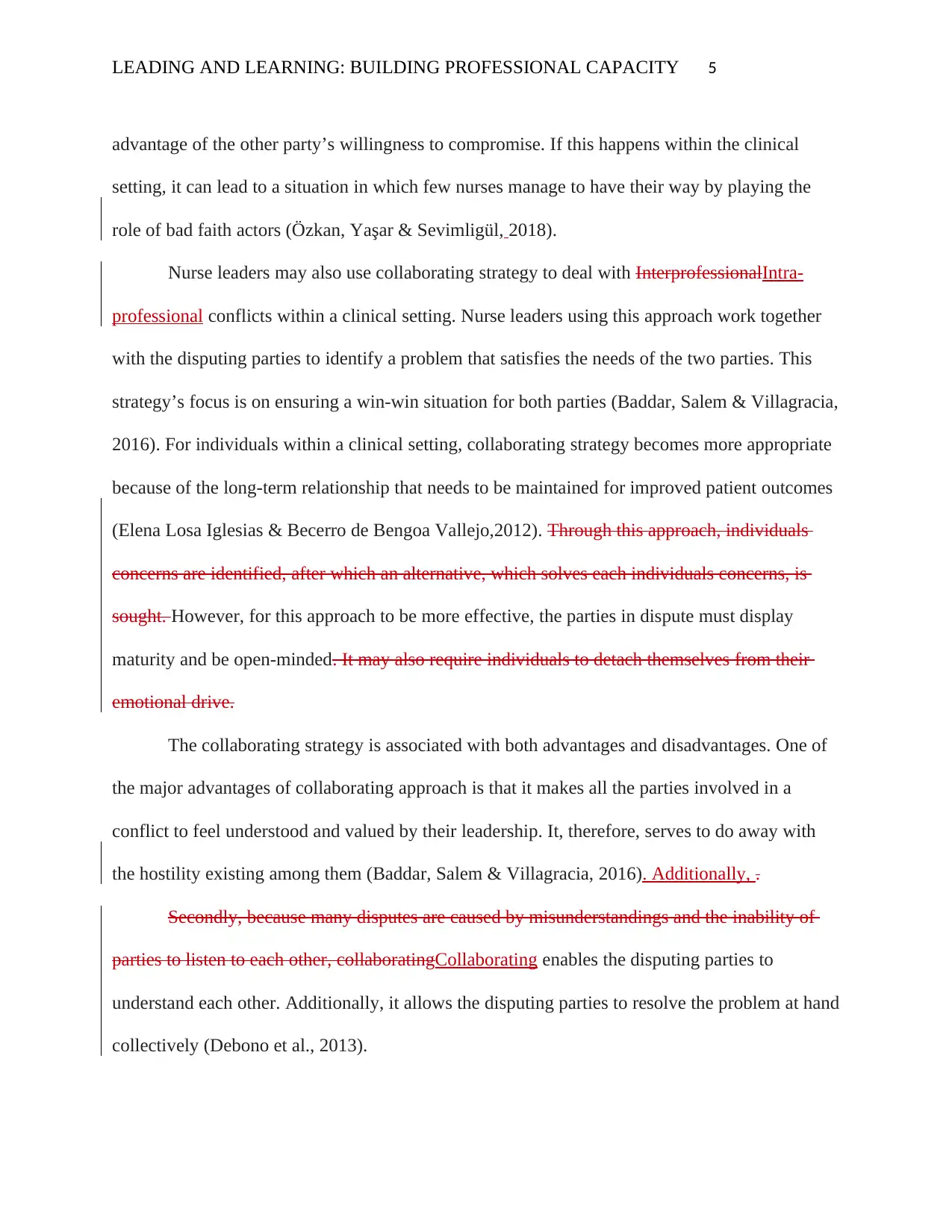
LEADING AND LEARNING: BUILDING PROFESSIONAL CAPACITY 5
advantage of the other party’s willingness to compromise. If this happens within the clinical
setting, it can lead to a situation in which few nurses manage to have their way by playing the
role of bad faith actors (Özkan, Yaşar & Sevimligül, 2018).
Nurse leaders may also use collaborating strategy to deal with InterprofessionalIntra-
professional conflicts within a clinical setting. Nurse leaders using this approach work together
with the disputing parties to identify a problem that satisfies the needs of the two parties. This
strategy’s focus is on ensuring a win-win situation for both parties (Baddar, Salem & Villagracia,
2016). For individuals within a clinical setting, collaborating strategy becomes more appropriate
because of the long-term relationship that needs to be maintained for improved patient outcomes
(Elena Losa Iglesias & Becerro de Bengoa Vallejo,2012). Through this approach, individuals
concerns are identified, after which an alternative, which solves each individuals concerns, is
sought. However, for this approach to be more effective, the parties in dispute must display
maturity and be open-minded. It may also require individuals to detach themselves from their
emotional drive.
The collaborating strategy is associated with both advantages and disadvantages. One of
the major advantages of collaborating approach is that it makes all the parties involved in a
conflict to feel understood and valued by their leadership. It, therefore, serves to do away with
the hostility existing among them (Baddar, Salem & Villagracia, 2016). Additionally, .
Secondly, because many disputes are caused by misunderstandings and the inability of
parties to listen to each other, collaboratingCollaborating enables the disputing parties to
understand each other. Additionally, it allows the disputing parties to resolve the problem at hand
collectively (Debono et al., 2013).
advantage of the other party’s willingness to compromise. If this happens within the clinical
setting, it can lead to a situation in which few nurses manage to have their way by playing the
role of bad faith actors (Özkan, Yaşar & Sevimligül, 2018).
Nurse leaders may also use collaborating strategy to deal with InterprofessionalIntra-
professional conflicts within a clinical setting. Nurse leaders using this approach work together
with the disputing parties to identify a problem that satisfies the needs of the two parties. This
strategy’s focus is on ensuring a win-win situation for both parties (Baddar, Salem & Villagracia,
2016). For individuals within a clinical setting, collaborating strategy becomes more appropriate
because of the long-term relationship that needs to be maintained for improved patient outcomes
(Elena Losa Iglesias & Becerro de Bengoa Vallejo,2012). Through this approach, individuals
concerns are identified, after which an alternative, which solves each individuals concerns, is
sought. However, for this approach to be more effective, the parties in dispute must display
maturity and be open-minded. It may also require individuals to detach themselves from their
emotional drive.
The collaborating strategy is associated with both advantages and disadvantages. One of
the major advantages of collaborating approach is that it makes all the parties involved in a
conflict to feel understood and valued by their leadership. It, therefore, serves to do away with
the hostility existing among them (Baddar, Salem & Villagracia, 2016). Additionally, .
Secondly, because many disputes are caused by misunderstandings and the inability of
parties to listen to each other, collaboratingCollaborating enables the disputing parties to
understand each other. Additionally, it allows the disputing parties to resolve the problem at hand
collectively (Debono et al., 2013).
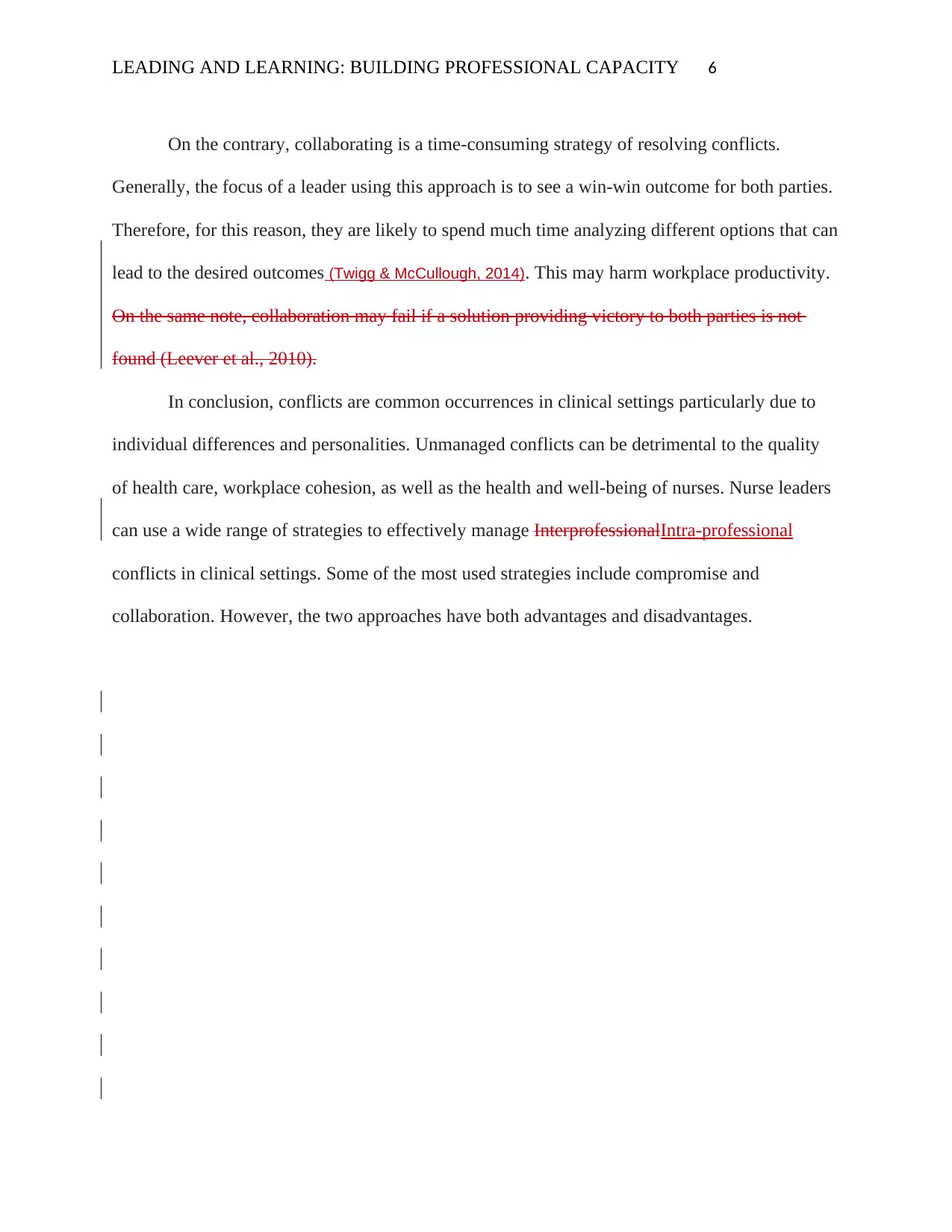
LEADING AND LEARNING: BUILDING PROFESSIONAL CAPACITY 6
On the contrary, collaborating is a time-consuming strategy of resolving conflicts.
Generally, the focus of a leader using this approach is to see a win-win outcome for both parties.
Therefore, for this reason, they are likely to spend much time analyzing different options that can
lead to the desired outcomes (Twigg & McCullough, 2014). This may harm workplace productivity.
On the same note, collaboration may fail if a solution providing victory to both parties is not
found (Leever et al., 2010).
In conclusion, conflicts are common occurrences in clinical settings particularly due to
individual differences and personalities. Unmanaged conflicts can be detrimental to the quality
of health care, workplace cohesion, as well as the health and well-being of nurses. Nurse leaders
can use a wide range of strategies to effectively manage InterprofessionalIntra-professional
conflicts in clinical settings. Some of the most used strategies include compromise and
collaboration. However, the two approaches have both advantages and disadvantages.
On the contrary, collaborating is a time-consuming strategy of resolving conflicts.
Generally, the focus of a leader using this approach is to see a win-win outcome for both parties.
Therefore, for this reason, they are likely to spend much time analyzing different options that can
lead to the desired outcomes (Twigg & McCullough, 2014). This may harm workplace productivity.
On the same note, collaboration may fail if a solution providing victory to both parties is not
found (Leever et al., 2010).
In conclusion, conflicts are common occurrences in clinical settings particularly due to
individual differences and personalities. Unmanaged conflicts can be detrimental to the quality
of health care, workplace cohesion, as well as the health and well-being of nurses. Nurse leaders
can use a wide range of strategies to effectively manage InterprofessionalIntra-professional
conflicts in clinical settings. Some of the most used strategies include compromise and
collaboration. However, the two approaches have both advantages and disadvantages.
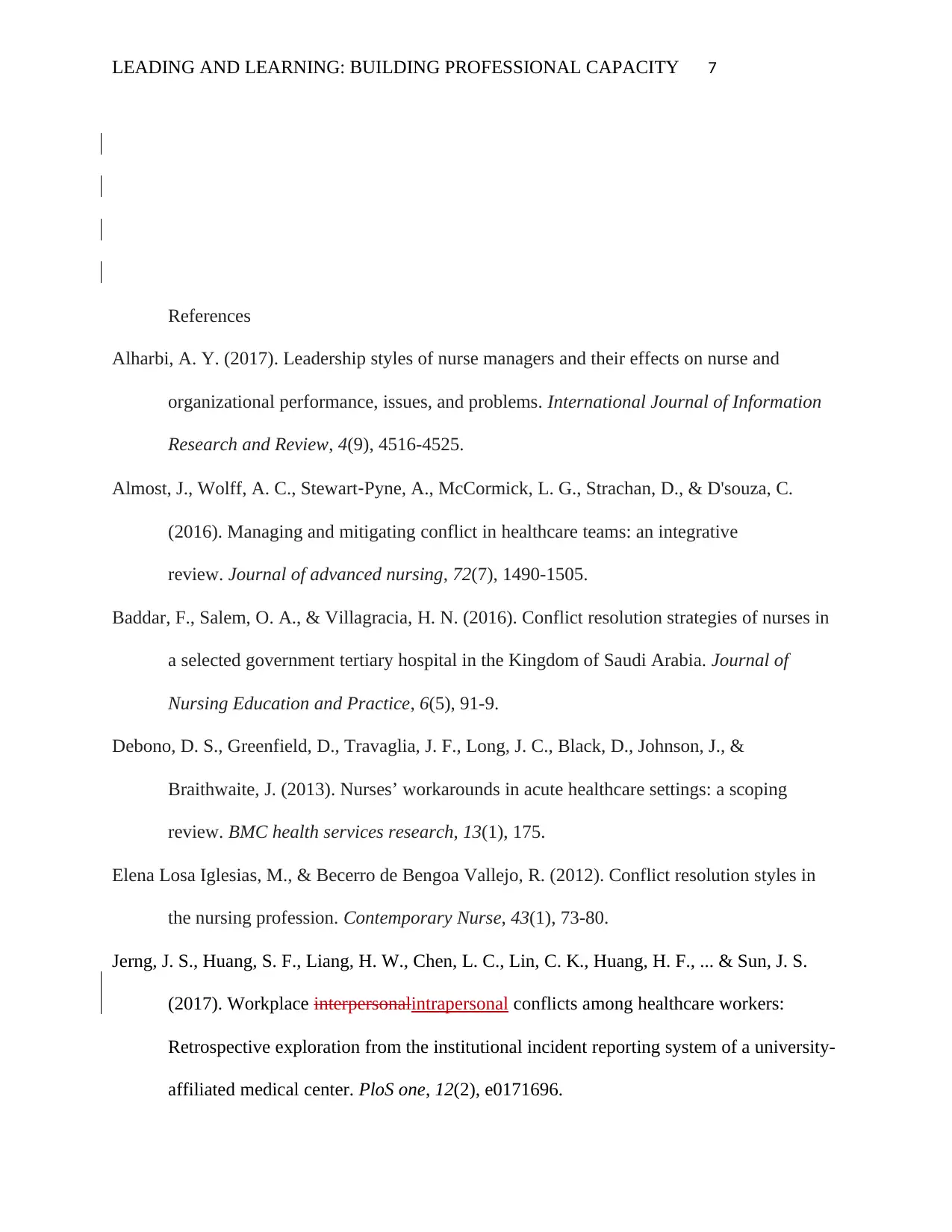
LEADING AND LEARNING: BUILDING PROFESSIONAL CAPACITY 7
References
Alharbi, A. Y. (2017). Leadership styles of nurse managers and their effects on nurse and
organizational performance, issues, and problems. International Journal of Information
Research and Review, 4(9), 4516-4525.
Almost, J., Wolff, A. C., Stewart‐Pyne, A., McCormick, L. G., Strachan, D., & D'souza, C.
(2016). Managing and mitigating conflict in healthcare teams: an integrative
review. Journal of advanced nursing, 72(7), 1490-1505.
Baddar, F., Salem, O. A., & Villagracia, H. N. (2016). Conflict resolution strategies of nurses in
a selected government tertiary hospital in the Kingdom of Saudi Arabia. Journal of
Nursing Education and Practice, 6(5), 91-9.
Debono, D. S., Greenfield, D., Travaglia, J. F., Long, J. C., Black, D., Johnson, J., &
Braithwaite, J. (2013). Nurses’ workarounds in acute healthcare settings: a scoping
review. BMC health services research, 13(1), 175.
Elena Losa Iglesias, M., & Becerro de Bengoa Vallejo, R. (2012). Conflict resolution styles in
the nursing profession. Contemporary Nurse, 43(1), 73-80.
Jerng, J. S., Huang, S. F., Liang, H. W., Chen, L. C., Lin, C. K., Huang, H. F., ... & Sun, J. S.
(2017). Workplace interpersonalintrapersonal conflicts among healthcare workers:
Retrospective exploration from the institutional incident reporting system of a university-
affiliated medical center. PloS one, 12(2), e0171696.
References
Alharbi, A. Y. (2017). Leadership styles of nurse managers and their effects on nurse and
organizational performance, issues, and problems. International Journal of Information
Research and Review, 4(9), 4516-4525.
Almost, J., Wolff, A. C., Stewart‐Pyne, A., McCormick, L. G., Strachan, D., & D'souza, C.
(2016). Managing and mitigating conflict in healthcare teams: an integrative
review. Journal of advanced nursing, 72(7), 1490-1505.
Baddar, F., Salem, O. A., & Villagracia, H. N. (2016). Conflict resolution strategies of nurses in
a selected government tertiary hospital in the Kingdom of Saudi Arabia. Journal of
Nursing Education and Practice, 6(5), 91-9.
Debono, D. S., Greenfield, D., Travaglia, J. F., Long, J. C., Black, D., Johnson, J., &
Braithwaite, J. (2013). Nurses’ workarounds in acute healthcare settings: a scoping
review. BMC health services research, 13(1), 175.
Elena Losa Iglesias, M., & Becerro de Bengoa Vallejo, R. (2012). Conflict resolution styles in
the nursing profession. Contemporary Nurse, 43(1), 73-80.
Jerng, J. S., Huang, S. F., Liang, H. W., Chen, L. C., Lin, C. K., Huang, H. F., ... & Sun, J. S.
(2017). Workplace interpersonalintrapersonal conflicts among healthcare workers:
Retrospective exploration from the institutional incident reporting system of a university-
affiliated medical center. PloS one, 12(2), e0171696.
Paraphrase This Document
Need a fresh take? Get an instant paraphrase of this document with our AI Paraphraser

LEADING AND LEARNING: BUILDING PROFESSIONAL CAPACITY 8
Johansen, M. L. (2012). Keeping the peace: conflict management strategies for nurse
managers. Nursing Management, 43(2), 50-54.
Leever, A. M., Hulst, M. V. D., Berendsen, A. J., Boendemaker, P. M., Roodenburg, J. L. N., &
Pols, J. (2010). Conflicts and conflict management in the collaboration between nurses
and physicians–A qualitative study. Journal of Interprofessional Care, 24(6), 612-624.
McKibben, L. (2017). Conflict management: importance and implications. British Journal of
Nursing, 26(2), 100-103.
Overton, A. R., & Lowry, A. C. (2013). Conflict management: difficult conversations with
difficult people. Clinics in colon and rectal surgery, 26(04), 259-264.
Özkan Tuncay, F., Yaşar, Ö., & Sevimligül, G. (2018). Conflict management styles of nurse
managers working in inpatient institutions: the case of Turkey. Journal of nursing
management, 26(8), 945-952.
Twigg, D., & McCullough, K. (2014). Nurse retention: A review of strategies to create and enhance
positive practice environments in clinical settings. International journal of nursing studies, 51(1),
85-92.
Yufenyuy Claris, S. (2018). Impact of InterprofessionalIntraprofessional Conflict on Quality
Nursing Care-Nurses' role.26(04), 229-234.
Johansen, M. L. (2012). Keeping the peace: conflict management strategies for nurse
managers. Nursing Management, 43(2), 50-54.
Leever, A. M., Hulst, M. V. D., Berendsen, A. J., Boendemaker, P. M., Roodenburg, J. L. N., &
Pols, J. (2010). Conflicts and conflict management in the collaboration between nurses
and physicians–A qualitative study. Journal of Interprofessional Care, 24(6), 612-624.
McKibben, L. (2017). Conflict management: importance and implications. British Journal of
Nursing, 26(2), 100-103.
Overton, A. R., & Lowry, A. C. (2013). Conflict management: difficult conversations with
difficult people. Clinics in colon and rectal surgery, 26(04), 259-264.
Özkan Tuncay, F., Yaşar, Ö., & Sevimligül, G. (2018). Conflict management styles of nurse
managers working in inpatient institutions: the case of Turkey. Journal of nursing
management, 26(8), 945-952.
Twigg, D., & McCullough, K. (2014). Nurse retention: A review of strategies to create and enhance
positive practice environments in clinical settings. International journal of nursing studies, 51(1),
85-92.
Yufenyuy Claris, S. (2018). Impact of InterprofessionalIntraprofessional Conflict on Quality
Nursing Care-Nurses' role.26(04), 229-234.
1 out of 8
Related Documents
Your All-in-One AI-Powered Toolkit for Academic Success.
+13062052269
info@desklib.com
Available 24*7 on WhatsApp / Email
![[object Object]](/_next/static/media/star-bottom.7253800d.svg)
Unlock your academic potential
© 2024 | Zucol Services PVT LTD | All rights reserved.




